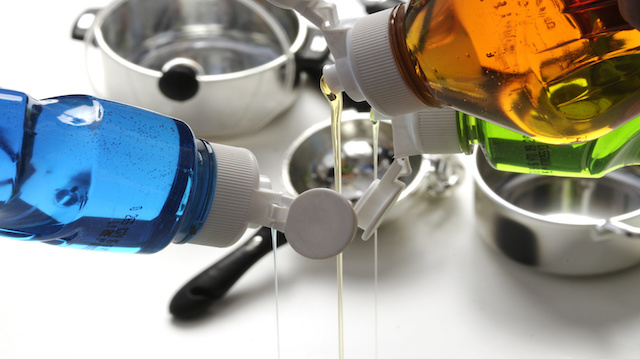
The saying, “It all comes out in the wash,” may be truer than you thought. Who knew that some dish soaps could be hazardous to your health and to the environment? In this article, we discuss three ingredients to be on the lookout for when grabbing that next bottle of dish soap. We’ve also come up with some natural solutions, from just changing brands, to using soap nuts or even making your own dish soap.
We know many people diligently read the labels on food products, but have you ever looked at a dishwashing soap label? Here are three things you should avoid in your dish soap (that don’t affect the cleaning, of course).
Skip the antibacterial dish soap
Is an antibacterial agent really needed in dish soap? Many of the biggest brands have an antibacterial version of dish soap, but we suggest you steer well clear of this option. A commonly used chemical in antibacterial dish soap is triclosan: a synthetic substance that can be found in soaps, detergents, surgical cleaning treatments, kitchenware, clothing and even toys.
Triclosan is currently under review by the U.S. Food and Drug Administration (FDA) because, according to the FDA, “Animal studies have shown that triclosan alters hormone regulation.” It not only alters animal hormones, it is also linked to creating resistant bacteria. Just when you think you’ve heard enough, you’re told it’s not good for the environment, either! According to research, triclosan is being considered an emerging environmental contaminant.
What’s the alternative if you want to get those dishes squeaky clean? Regular dish soap, water and some elbow grease are just as effective. So skip the brands that add in an antibacterial agent.
Forgo fragrance
We aren’t talking about natural essential oils here. If you take a gander at the ingredient list of many commercial dish soaps to see what chemicals are included for fragrance, you might let out a little gasp. Chemical fragrance can cause skin problems and allergies in some (we’ve raised our hands), and it does nothing to improve the washing power of the soap. Finding a natural, fragrance-free brand is easy. And who knows? You might notice you’re breathing a little easier, too.
No artificial dyes
Many of today’s soaps contain “varying degrees” (this is how the manufacturers word it) of yellow, red or blue dye. These dyes are concocted in the laboratory. Under fire today, are Yellow Dye 5 and 6, which were shown to cause hyperactivity in children in a recent U.K. study. Red Dye no. 5 is banned from food products in the United States, so why put it in dish soap? We recommend you opt for a dye-free version.
What to do
- Be more diligent reading labels. Think, simple is better — the fewer ingredients the better.
- Soap nuts: If you want to be ultra-safe and are willing to part with bubbles, you can make a dish soap using soap nuts.
- DIY dish soap: You can make your own hand and dish wash soap. Below are three simple recipes to try. All are borax-free. The first two are recipes for dish washing soap, while the third is for use in the dishwasher.
Homemade Dish Washing Soap
Ingredients
- 2 cups water
- 1/4 cup all natural soap flakes or grated soap
- 1/4 cup castile soap
- 2 tsp super washing soda
- 1 tsp vegetable glycerin, optional
- 30 of drops essential oil, optional
Instructions
- Bring water to a boil. Add grated soap and stir until dissolved.
- Pour in castile soap and super washing soda.
- Add glycerin and an essential oil of your choice. Stir until homogenous.
- Let it set overnight. Pour into a dish wash bottle.
3 Ingredient Dish Washing Soap
Ingredients
- 1/2 cup water
- 1/2 cup castile soap
- 1 tsp Kosher salt
Instructions
- Bring water to a boil. Add soap and stir.
- Add salt and slowly stir until dissolved.
- Let it sit overnight. Then pour into a dish wash bottle.
Dishwashing Detergent
Ingredients
 1 cup washing soda
1 cup washing soda- 1/4 cup citric acid
- 1/4 cup coarse salt
- 10–15 drops of a preferred essential oil, optional
- Distilled white vinegar (add separately to dish washer)
Instructions
- Mix washing soda, citric acid and salt in a sealable container.
- Add essential oil and make sure it is thoroughly mixed in.
- Fill your rinse aid compartment with the distilled white vinegar. Use 1 teaspoon to 1 tablespoon of detergent, depending on the size and dirtiness of your dishes.
Finding a natural alternative to chemical-laden dish soap is another great way to keep you and your family safe and healthy.
—Nikki Walsh
Nikki Walsh is a freelance writer and mom of two kids living in Southern California. She holds an MBA in marketing from University of California, Irvine and a bachelor’s degree in Biochemistry from UCSD. She has been practicing Kelee meditation for 19 years. When she is not writing she can be found out and about having fun with her kids.
Sources:
http://www.fda.gov/ForConsumers/ConsumerUpdates/ucm205999.htm
http://onlinelibrary.wiley.com/doi/10.1111/j.1574-6968.2001.tb10772.x/pdf
https://www.researchgate.net/profile/Rachel_Skirrow/publication/6783914_The_Bactericidal_Agent_Triclosan_Modulates_Thyroid_Hormone-Associated_Gene_Expression_and_Disrupts_Postembryonic_Anuran_Development/links/0deec524c3368a304f000000.pdf
https://www.researchgate.net/publication/225278523_Biodegradation_of_triclosan_by_a_wastewater_microorganism
http://www.thelancet.com/journals/lancet/article/PIIS0140673607613063/abstract
http://www.thealternativedaily.com/soap-nuts-natural-laundry-soap-doubles-hair-shampoo-household-cleaner

